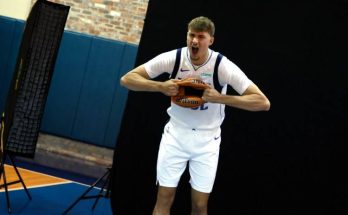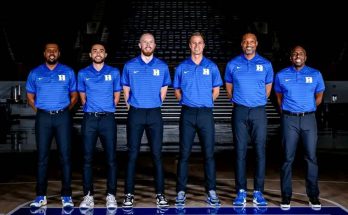The Detroit Lions have entered the 2025 NFL season with renewed optimism, and leading the charge in their wide receiver room is an unexpected but riveting story: rookie Isaac TeSlaa. Emerging alongside established stars Amon‑Ra St. Brown and Jameson Williams, TeSlaa now headlines a revamped receiving corps after the team traded veteran Tim Patrick. This transition signals a shift not just in roster construction, but in the very identity of Detroit’s passing game.
Isaac TeSlaa’s ascent began long before he was drafted. A Michigan native from Hudsonville, he excelled as a high school quarterback, guiding Unity Christian to a state championship and proving his athleticism across sports like basketball and track and field. Despite limited recruiting interest—only one Division I offer—he went on to dominate at Division II Hillsdale College, where he posted over 1,300 yards and 13 touchdowns in one season, earning conference Offensive Player of the Year honors (Wikipedia, Last Word On Sports). His production may have quieted in two seasons at Arkansas, but his 896 receiving yards, five touchdowns, and remarkable 19.5-yard average per catch established him as a big-play threat. With zero drops on his record, his hands and reliability were obvious assets (detroitlions.com, Wikipedia).
Detroit’s front office took notice. Despite skepticism from various draft analysts—ESPN’s Mel Kiper ranked TeSlaa 149th among receivers—the Lions traded up in the third round, giving up pick 102 and two third-round selections to land their hometown standout at No. 70 (Michigan’s Thumb, detroitlions.com, Last Word On Sports). GM Brad Holmes called TeSlaa his “favorite wide receiver in this draft,” noting that favorable production wasn’t everything, especially from a player with TeSlaa’s physical tools and character (Last Word On Sports, NFL.com). His explosive athleticism—4.43‑second 40-yard dash, 39.5‑inch vertical, 10‑foot‑9 broad jump—paired with size and toughness, reaffirmed why the Lions believed in him (detroitlions.com).
TeSlaa signed quickly, agreeing to a four-year rookie deal worth—reportedly—$6.65 million with a signing bonus of about $1.486 million, plus modest workout bonuses (Pride Of Detroit). His devotion to the franchise was evident: he showed up to a pre-draft visit in a Lions jersey and has been referred to as “born to be a Lion” (ESPN.com, detroitlions.com). He brings both hometown pride and a football IQ aligned with Detroit’s cultural identity.
From camp football to the preseason field, TeSlaa showcased the raw ability and work ethic that made him stand out. In training camp, he delivered eye‑popping catches—skyed over Avonte Maddox for a contested grab, displayed slick route-running to create separation—even as a developmental rookie (detroitsportsnation.com). GM Holmes and veteran Amon‑Ra St. Brown both praised his physicality. Holmes commented that no one had blocked downfield like TeSlaa since St. Brown’s rookie year, and St. Brown called him “tough, real tough,” often reminding him to “take it easy” when his aggression verged on injury risk (NFL.com).
TeSlaa’s preseason debut was immediately impactful: two catches for 46 yards in a harsh 34‑7 loss to the Chargers, trucking a defender with physicality and demonstrating composure despite “nervous anticipation” (detroitsportsnation.com). The pinnacle came in the preseason finale vs. Houston, when TeSlaa hauled in a 33-yard touchdown, capped with a break‑dance “worm” that went viral (Newsweek, SI). Overall, he totaled 10 receptions for 146 yards and three touchdowns in preseason, earning a PFF grade of 90.4—the highest of any Lions offensive player in that game (M Sports).
That consistency didn’t go unnoticed. Coaches are giving serious consideration to an early-season role for TeSlaa, who has already moved from college slot receiver to contributing as both slot and outside wideout in Detroit’s offense. His ability to work against top coverage and play special teams has boosted staff confidence (Pride Of Detroit, New York Post).
Meanwhile, Tim Patrick—a veteran wideout signed in 2024—was traded to the Jacksonville Jaguars during roster cuts on August 27, 2025. In 2024, Patrick had contributed 33 catches for 394 yards and three touchdowns, playing in 16 games and starting nine. His blocking was valued in Detroit’s scheme, but he didn’t replicate that in camp this year, and the rise of TeSlaa rendered the veteran expendable (Pride Of Detroit). The trade freed up a roster spot and cap space, signaling the Lions’ commitment to the youth movement and TeSlaa’s role in it (New York Post).
In a receiver group anchored by All‑Pro Amon‑Ra St. Brown—one of the most complete receivers in football—and devastating speedster Jameson Williams, TeSlaa now shares top billing as the emerging No. 3. While St. Brown remains the focal point of the passing attack and Williams the deep threat, TeSlaa offers a unique combination of size, athleticism, and physicality that complements both (detroitlions.com, ESPN.com). He won’t replace their production immediately, but he brings an identity as a contested‑catch threat, special‑teams asset, and gritty blocker in run support—qualities the Lions value deeply.
Detroit’s offense, now under new coordinator John Morton, is expected to lean on its ground game to open up the passing attack, with Jahmyr Gibbs and David Montgomery providing solid support. In that scheme, a big-bodied receiver who blocks downfield and can stretch the field vertically is a valuable tool (New York Post, Pride Of Detroit, Last Word On Sports). With TeSlaa, the Lions have added a player born out of their stylistic ethos—tough, dedicated, and willing to do the dirty work.
More than just tools, TeSlaa seems to have the intangibles. His humility, understanding of his development path, and fierce willingness to earn trust from coaches and teammates have defined his outlook as much as his physical gifts. He said that being able to build trust with the play‑callers and the locker room is his “ultimate goal” as a rookie (M Sports).
Amid Lions fandom and rising expectations, TeSlaa has earned attention off the field too. In a lighthearted rookie challenge (painting the Lions logo from memory), he impressed fans by accurately recreating the emblem—another sign he’s deeply invested in the organization’s culture (Pride Of Detroit).
Now, as the regular season nears, fans and analysts are watching to see if TeSlaa’s August flame can burn through September and October. He may not hit 900-yard rookie territory like St. Brown did, but TeSlaa’s diverse contributions—run support, contested catches, special teams, and red zone potential—could make him indispensable even in limited targeting scenarios (NFL.com, Last Word On Sports). In a league where size, speed, and toughness can turn raw upside into real results, Detroit’s No. 70 pick may just be the missing link in a high-octane offense.
Detroit opened the season on the road against Green Bay on September 7, and with TeSlaa now entrenched in the WR rotation, the Lions enter 2025 with more depth, versatility, and personality in their receiving corps than ever before (New York Post).
Isaac TeSlaa’s journey—from under‑recruited high school QB to Division II star, SEC standout, hometown draft pick, and now heir to a WR room—reads like a movie script. Yet so far, his story is proving to be real. As the Lions move forward, TeSlaa stands as a testament to what Detroit’s front office values: character, athletic tools, and a relentless willingness to earn every rep. In headlining the WR room, he’s more than earned his spot—he’s embraced the role and carries the Lions’ honest, blue‑collar spirit forward.



